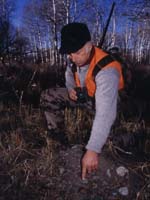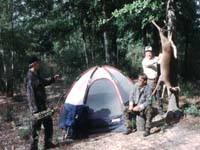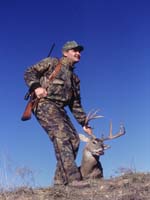
|
Features
|
|
|
|
Books
|
|
|
|
Fun & Games
|
|
|
|
Contact Us
|
|
|
John's Journal... Entry 65, Day 5
Escape Trails and Night Trails
 EDITOR'S
NOTE: Simply finding a deer trail won't provide enough information
to make you hang a tree stand and plan to hunt that trail. Many ingredients
make some deer trails better than others. To effectively hunt trails,
you need to know ..
EDITOR'S
NOTE: Simply finding a deer trail won't provide enough information
to make you hang a tree stand and plan to hunt that trail. Many ingredients
make some deer trails better than others. To effectively hunt trails,
you need to know ..
* why and when the deer use the trail,
* where the deer will go and
* what time of day or night the deer will move down the trail.
With this information, you can hunt trails and take deer more productively than a hunter who simply finds a trail and hangs a tree stand. Let's take a closer look at some different types of deer trails and what you can learn from these trails to help you hunt more effectively.
Apartment buildings, hotels and department stores all have fire escapes. Even elevators have trapdoors in their ceilings for people to escape danger. The white-tailed deer realizes the presence of danger in his environment, especially during hunting season. That's why the buck has certain, pre-determined paths he uses to escape danger. Often these trails won't look well-defined and may show little wear.
 Once
a longtime deer hunter uncovered an unusual escape trail under a bridge.
Each morning before hunting season when the hunter scouted, he noticed
a nice buck in a greenfield on his club, However, when deer season arrived,
he rarely saw the buck in the field but would spot him on the opposite
side of the creek at first light as the hunter went into the woods to
hunt.
Once
a longtime deer hunter uncovered an unusual escape trail under a bridge.
Each morning before hunting season when the hunter scouted, he noticed
a nice buck in a greenfield on his club, However, when deer season arrived,
he rarely saw the buck in the field but would spot him on the opposite
side of the creek at first light as the hunter went into the woods to
hunt.
After scouting for several weeks, the hunter still couldn't pinpoint how the buck got away from the field to the opposite side of the creek. Finally one morning, he left to hunt somewhat earlier and found the buck a little late leaving the greenfield. The hunter watched as the buck walked under the bridge everyone used to travel to go hunting.
When daylight came, the hunter located the buck's trail where it went into the water just below the field. Checking under the bridge, he saw a small sandbar with plenty of tracks going both ways that the buck had used to travel back and forth to the field. The following morning the hunter took the buck on this escape route.
Many of us probably waste thousands of hours hunting over trails deer never use during daylight hours. To decide whether or not a deer uses a trail at night, check the numbers of tracks on it. If the trail goes straight in one direction, then you'll know deer don't meander along these trails and feed, walk these trails in search of does or take these paths to and from food sources during daylight hours.
 Like
us when we're traveling from one point to another, deer will take a woods
interstate, because it's the most direct route. However, if we want to
pick up a date, get something to eat or have a visit with friends, we
must get off the highway and so must deer. You can easily see these night
trails in open woodlots. To determine whether or not these paths have
deer on them, use a trail timer.
Like
us when we're traveling from one point to another, deer will take a woods
interstate, because it's the most direct route. However, if we want to
pick up a date, get something to eat or have a visit with friends, we
must get off the highway and so must deer. You can easily see these night
trails in open woodlots. To determine whether or not these paths have
deer on them, use a trail timer.
But remember, the ease of locating these well-defined night trails means many people will hunt here, although usually the trails will have the most hunting pressure during daylight hours. To avoid the hunter, the deer using this trail only will come out after dark.
After gathering information about where the deer go and why they travel to these regions, then you must determine when, and where to try and put a tree stand to bag a buck. When a big buck moves down that deer highway at a time you have pre-determined he will, and you sight in on your target, you'll understand immediately why all your research and scouting for trails have been worthwhile.
Check back each day this week for more about Reading Whitetails' Travel Routes ...
Day 1 -Types of Whitetail
Highways
Day 2 -Trash Trails and Meandering Trails
Day 3 -Terrain Trails and Mating Trails
Day 4 -Water, Food and Bedding Trails
Day 5 -Escape Trails and Night Trails